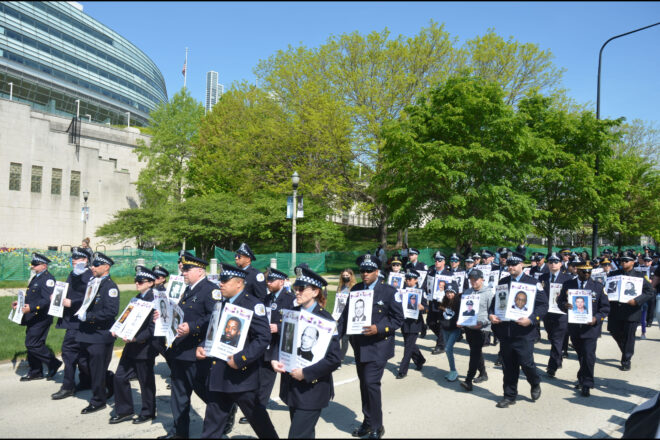Our published articles have appeared in research journals and professional public safety and policing publications. Our topic areas focus on community policing, juvenile delinquency, gang crime, violence, police operations, supervision, management accountability and leadership. These formally published articles are provided as a professional resource. Read and join the discussion by clicking on the links to each article below.
Published Articles Index
Additionally, our online posts, editorials, research analysis, and training insights are provided in our In the News & Research Section. Selected posts have been republished through our collaboration with LawOfficer.com.
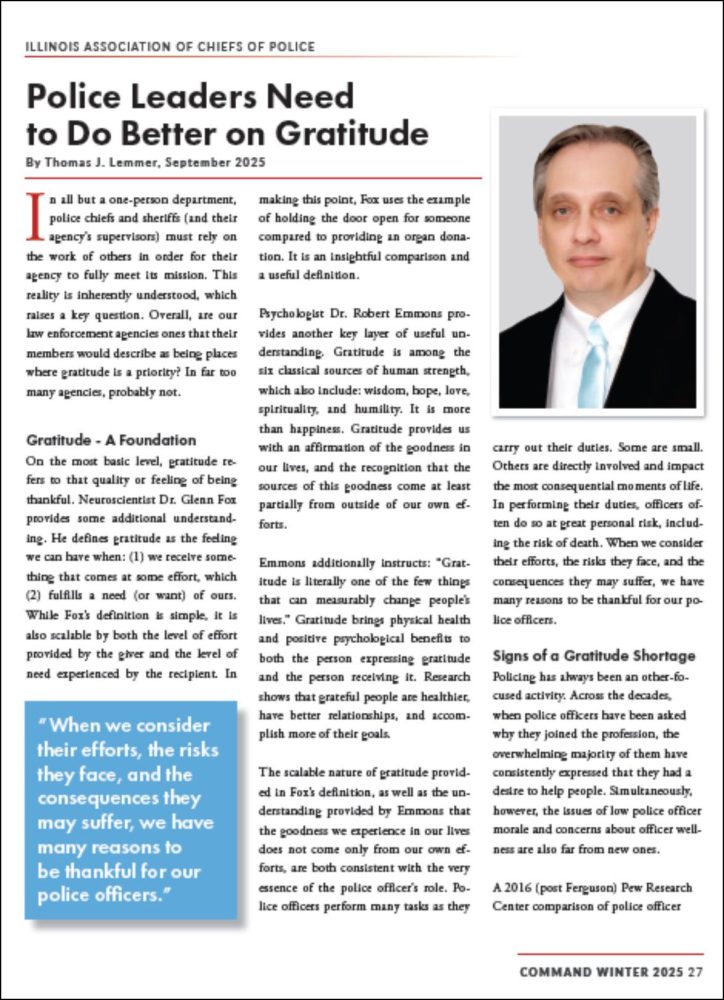
Police Leaders Need to Do Better on Gratitude
Abstract: This article was written by Thomas Lemmer as a companion to his training presentation created for the 2025 Illinois Association of Chiefs of Police (ILACP) annual training conference. Gratitude must be a guiding factor in how police leaders perform their duties. How they express appreciation is important.
Demonstrating that the efforts of their officers are appreciated contributes to the overall wellness of both the officers and the supervisors expressing gratitude. People receiving gratitude tend to become more grateful themselves, and grateful people experience improved physical and mental health. They are more optimistic, and deal with adversity better. These are clearly valuable traits to encourage among our officers.
This article was published in the Winter 2025 issue of of the Command Magazine by the Illinois Association of Chiefs of Police, pages 27-29.

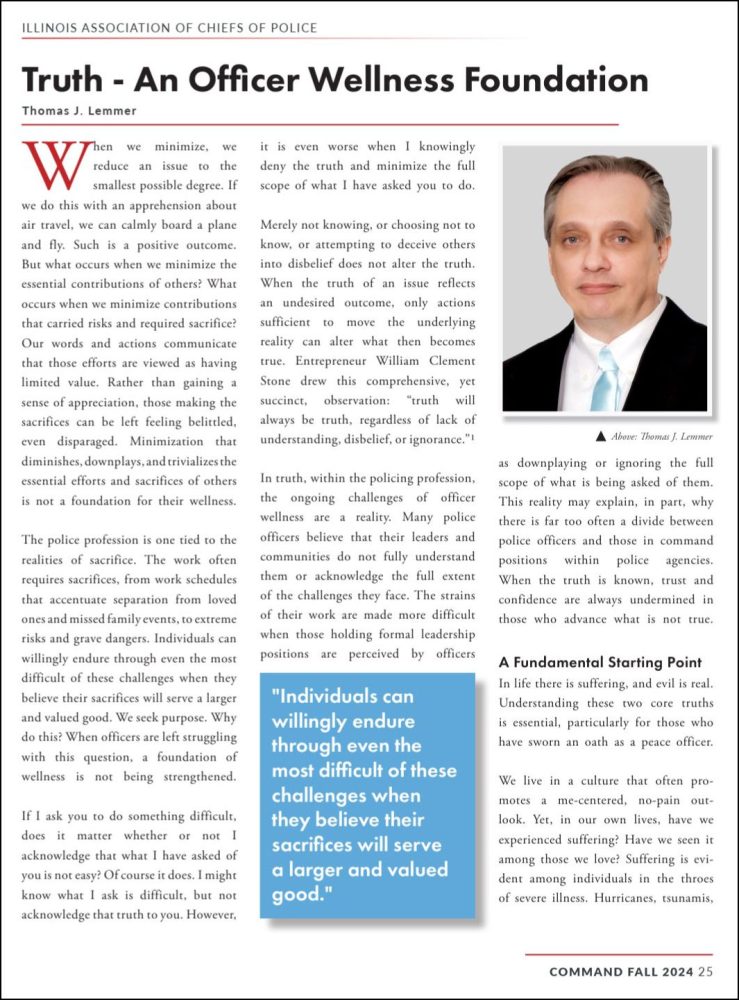
Truth – An Officer Wellness Foundation
Abstract: This article was written by Thomas Lemmer as a companion to his training presentation created for the 2024 Illinois Association of Chiefs of Police (ILACP) annual training conference. Policing has always been a challenging profession that has carried with it great responsibilities and extreme risks. This truth must be fully embraced.
What occurs when we minimize efforts and contributions that carry with them great risks and required sacrifice? Our words and actions communicate that those efforts are viewed as having limited value. Rather than gaining a sense of appreciation, those making the sacrifices can be left feeling belittled, even disparaged. Minimization that diminishes, downplays, and trivializes the essential efforts and sacrifices of others is not a foundation for their wellness.
This article was published in the Fall 2024 issue of of the Command Magazine by the Illinois Association of Chiefs of Police, pages 25-27.


Believe in Redemption
Abstract: This article provides a powerful reminder about the connection between policing and redemption. How we live our lives points each of us to certain ends. But as observed by Charles Dickens through his classic A Christmas Carol, if the paths change, so too can the ends change.
In performing their law enforcement duties, our police officers have the opportunity to change minds and touch hearts. Whenever any of us have the opportunity to help someone on their path to redemption, we should do so. Such is true to the policing mission.
This article was published in the May 2024 issue of The Peacemaker by the Fellowship of Christian Peace Officers – Canada (FCPO Canada), pages 18-19.

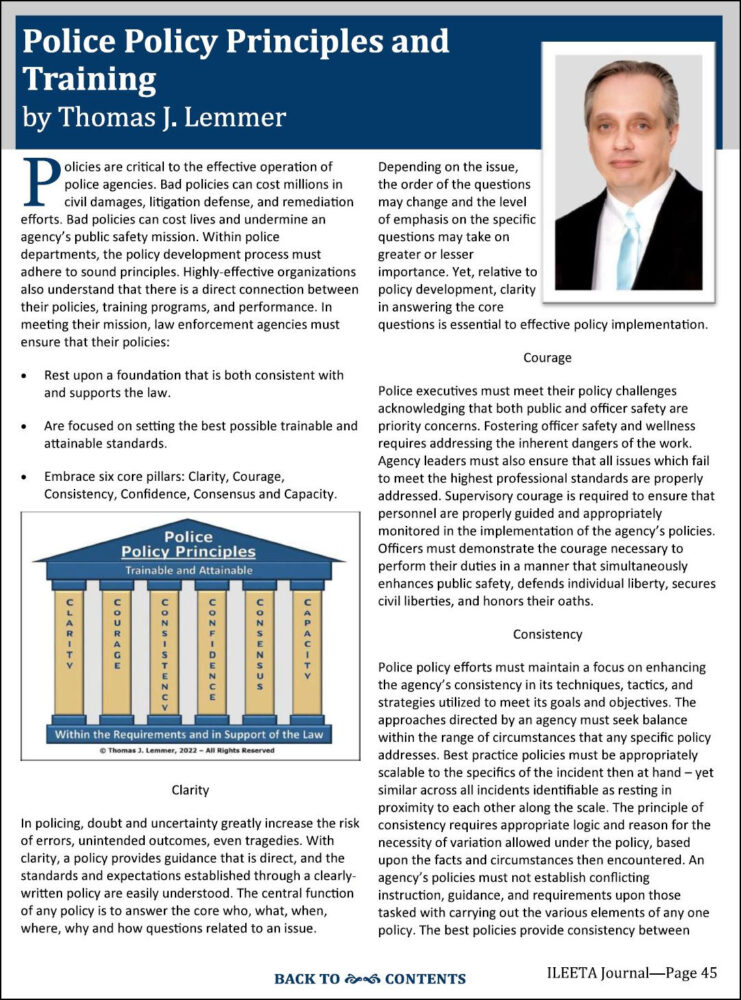
Police Policy Principles and Training
Abstract: This article was written by Thomas Lemmer as a companion to his training presentation created for the 2023 ILEETA Annual Conference. Now in its 20th year, each year this conference is a premier event for those who provide training to law enforcement personnel.
The article provides a concise summary of his Police Policy Principles model. Through the model, law enforcement agencies are provided key guidance on how they should approach and evaluate their policy development efforts. In meeting their mission, police agencies must ensure that their policies advance and adhere to three core principles.
First, their policies must rest upon a foundation that is both consistent with and supports the law. Second, they must be focused on setting the best possible trainable and attainable standards. Third, they must embrace six core pillars: Clarity, Courage, Consistency, Confidence, Consensus and Capacity.
Fostering a Highly-Effective Police Agency
Lemmer advises good policies are critical to the effective operation of police agencies. Bad policies can cost millions in civil damages, litigation defense, and remediation efforts. Bad policies can cost lives and undermine an agency’s public safety mission. Highly-effective police organizations establish and adhere to sound policies that allow them to simultaneously ensure constitutional policing, enhance public safety, and foster officer wellness. Highly-effective police agencies also ensure that their policy implementation and training programs efforts are coordinated efforts.
This article was published in the March 2023 (Volume 13, Edition 1) issue of the ILEETA Journal by the the International Law Enforcement Educators and Trainers Association, pages 45-46.

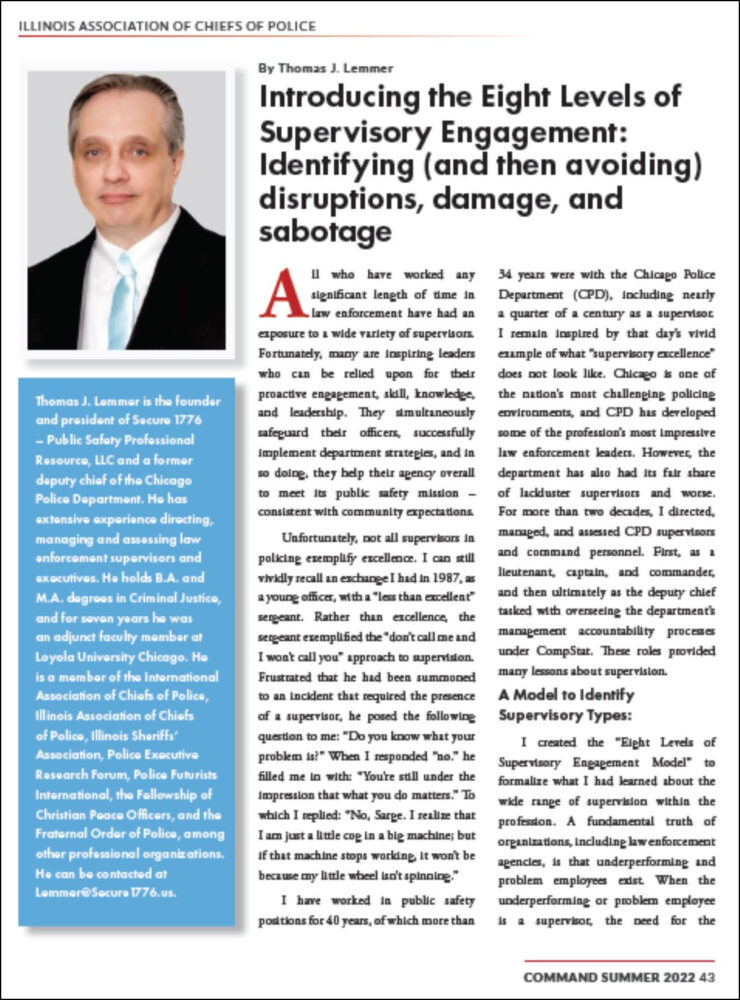
Introduction to the Eight Levels of Supervisory Engagement
Abstract: In this article our founder, Thomas Lemmer, provides an introduction to his Eight Levels of Supervisory Engagement Model. The article is a follow-up to the executive seminar Lemmer conducted for the members of the Illinois Association of Chiefs of Police at their annual conference held in April 2022.
The article begins with an exchange Lemmer had with an uninspiring sergeant early in his career. Of this interaction, he remarked: “I have worked in public safety positions for forty years, of which more than 34 years were with the Chicago Police Department (CPD), including nearly a quarter of a century as a supervisor. I remain inspired by that day’s vivid example of what “supervisory excellence” does not look like.”
The Engagement Levels
Police supervisors performing at the excellence level, simultaneously safeguard their officers, successfully implement department strategies, and in so doing, they help their agency overall to meet its public safety mission – consistent with community expectations. “Supervisory excellence,” is the highest of eight levels Lemmer’s model has identified through the examination of three key variables. They are (1) the level of technical knowledge and tactical skill; (2) the willingness of a supervisor to direct subordinates and proactively address performance issues; and (3) level to which the supervisor has come to reject (that is deviate) from the organization’s values, goals, and strategies.
The lowest and most concerning level of supervisory engagement is identified as “supervisory sabotage.” Such supervisors actively question organizational approaches, and discourage others from positive performance. Even worse, they may have alternate objectives. These supervisors jeopardize both the well-being of their officers and the ability of their agencies to meet their public safety mission.
Fostering Excellence
Lemmer advises that just as what police officers do matters: “What we do as police supervisors and executives matters as well.” To this end, the model also provides 19 separate leadership response strategies to be used in fostering an environment of supervisory excellence within a law enforcement agency.
This article was published in the Summer 2022 issue of the Command Magazine by the Illinois Association of Chiefs of Police, pages 43-46.

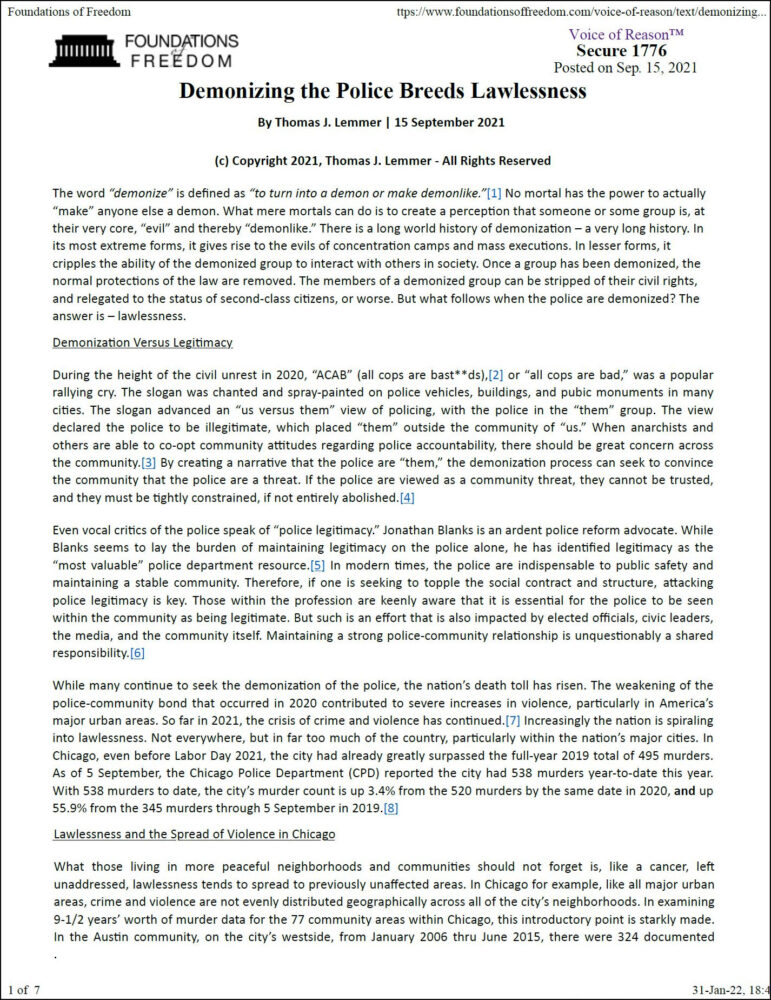
Demonizing the Police Breeds Lawlessness
Abstract: As noted in this article, “there is a long world history of demonization – a very long history. In its most extreme forms, it gives rise to the evils of concentration camps and mass executions. In lesser forms, it cripples the ability of the demonized group to interact with others in society. Once a group has been demonized, the normal protections of the law are removed. The members of a demonized group can be stripped of their civil rights, and relegated to the status of second-class citizens, or worse. But what follows when the police are demonized? The answer is – lawlessness.”
In 2020 and 2021, America experienced rising violence, including a historic year-over-year percentage increase in the nation’s murder rate. During this time, there were various levels of demonization of policing in Chicago, and in urban areas across the nation. Protests, vocal criticism, tepid support (and even outright attacks) from key elected officials, a drumbeat of negative media coverage, and expanded and critical monitoring by a host of entities. In cities, like Chicago, lower-crime areas, including its central business district and entertainment areas, witnessed a rise in lawlessness.
The Chicago Example
Yet, it was the areas with long histories of violent crime in Chicago (and such areas in cities like Chicago) that suffered most. For the period ending June 2021, the murder rate in the city’s West Garfield Park community was 225.3 per 100k. This astronomically high rate placed West Garfield Park as the community with the highest murder rate in the city. That rate reflected a year-to-year increase of 42.8%, from the 157.8 per 100k rate during the twelve months ending in June 2020. By comparison, the FBI’s Uniformed Crime Reporting data placed the 2019 national murder rate at 5.0 per 100k.
In the aftermath of the 7 August 2021 murder of Chicago Police Officer Ella French, and the life-altering wounding of her partner Carlos Yanez, Jr., Chicago Mayor Lori Lightfoot assembled the press. In her remarks she made a point of stating, “the police are not evil.” Such remarks suggest the mayor was concerned that this demonized view was held by at least some in the city.
This article was first published in the “Voices of Reason” section of the Foundations of Freedom website in 2021. It was republished January 2022 on the LinkedIn platform.

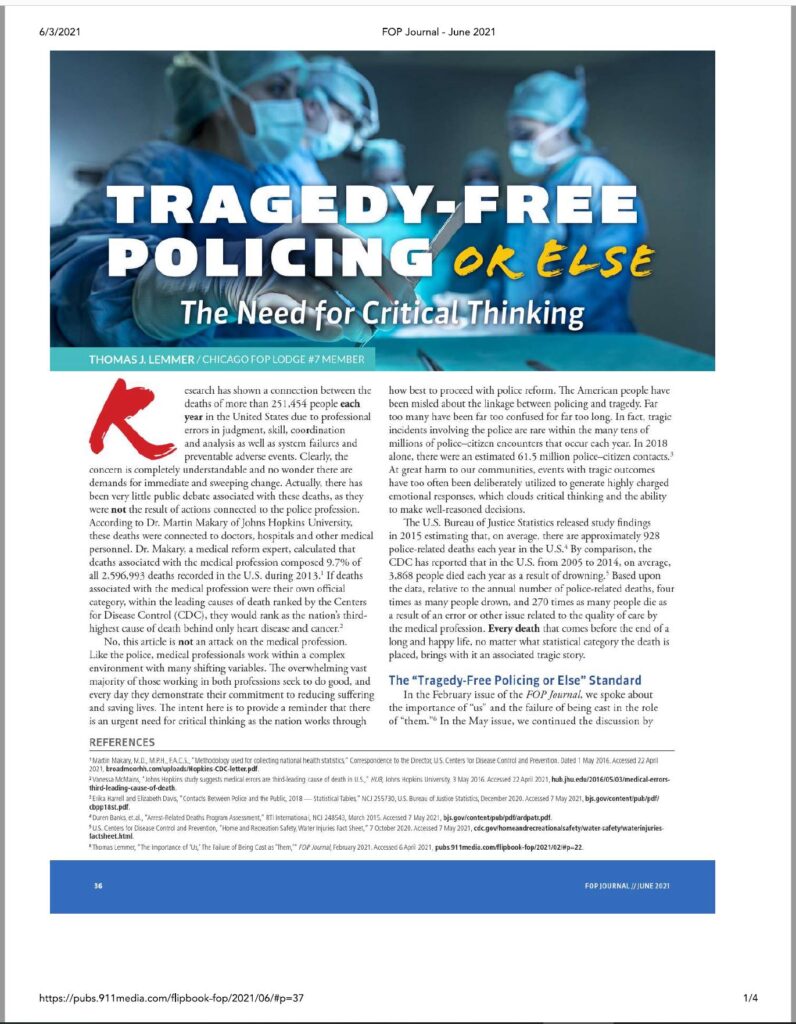
Tragedy-Free Policing or Else: The Need for Critical Thinking
Abstract: What is “tragedy-free policing?” It is a worldview that the police must proceed without taking any actions that could cause harm, without using force, and without ever making a mistake. Using a baseball analogy, the standard seeks “no runs, no hits, no errors.”
From this view, no one ever runs from the police, and if they do run, the police should not pursue after them, as even in foot pursuits some “harm” may occur. Second, no one should be forced to comply with any police order, seeking voluntary compliance is the only acceptable approach for the police. Third, all police actions must be error-free, without exception. The very nature of policing regularly necessitates propelling police officers into circumstances that are not of their own making, and into situations that are already tragic or at grave risk of quickly turning tragic.
The Reality of Tragedy and Policing
On a fundamental level, the duties we as a community assign to our police officers require them to: (1) be on watch to help prevent tragedies from occurring, (2) try to intervene when tragedies begin to unfold, and (3) respond in their aftermath. Policing is inherently wrapped in the perpetual vulnerability of tragedy. Based upon the data, relative to the annual number of police-related deaths, four times as many people drown, and 270 times as many people die as a result of an error or other issue related to the quality of care by the medical profession.
Every death that comes before the end of a long and happy life, no matter what statistical category the death is placed, brings with it an associated tragic story. Tragedy-free medicine, tragedy-free policing, tragedy-free life in this world is unattainable. There will be tragedies – and we must learn from them. We must transcend the tragedies that occur, and we must strive to lessen suffering where we can. The way forward must be a proactive one. In this effort, it is essential for us not to be deceived by those who are seeking perpetual division for their own ideological and political purposes.
More on the Way Forward
When the police are one with the community, the community is safer, freer, more stable, and better positioned to help foster the improved health and well-being of all the community’s members. Those seeking and participating in police reform efforts must not lose sight of this reality, and they must see the detriment to the community that comes with a tragedy-free-policing-or-else standard and reject it. Police accountability efforts must distinguish between unintended or unavoidable tragedy and true misconduct. This article was published in the June 2021 issue of the FOP Journal by the National Fraternal Order of Police, pages 36-39.

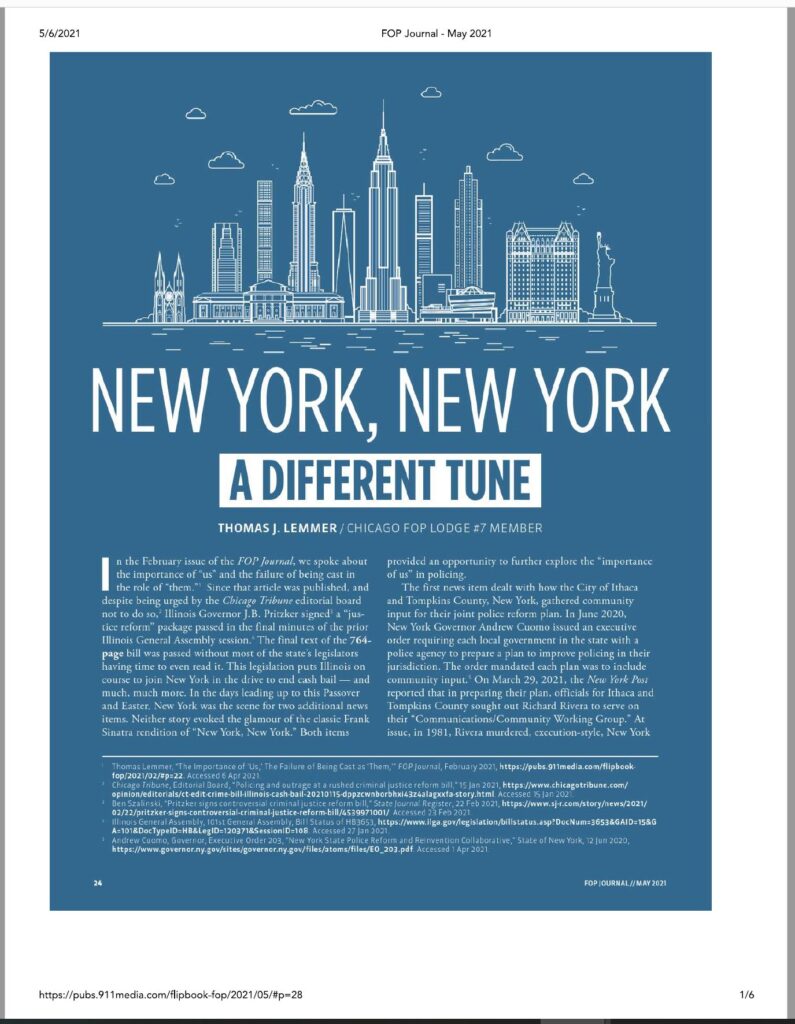
NewYork, NewYork: A Different Tune
Abstract: In the days leading up to Passover and Easter in 2021, New York was the scene for two key news items. Neither story evoked the glamour of the classic Frank Sinatra rendition of “New York, New York.” Both news items directly related to the topic of public safety.
Both items also provided an opportunity to further explore the “importance of us” in policing.
Whose Voices Are Included?
The first news item, dealt with how the City of Ithaca and Tompkins County, New York gathered community input for their joint police reform plan. In June 2020, New York Governor Andrew Cuomo issued an executive order requiring each local government in the state with a police agency to prepare a plan to improve policing in their jurisdiction. The order mandated each plan was to include community input. On March 29, 2021, the New York Post reported that in preparing their plan, officials for Ithaca and Tompkins County sought out Richard Rivera to serve on their “Communications/Community Working Group.” At issue, in 1981, Rivera murdered execution style, New York City Police Officer Robert Walsh.
Not Without Consequences
The second news item, covered the brutal attack of an elderly woman as she was walking to church on March 29, 2021, the Monday of Holy Week – in broad daylight – in Manhattan. Surveillance video showed a large man walk toward the 65-year-old woman less than half of his physical size. Without any provocation, the man kicked her in the chest, and continued to kick and stomp her as she lay defenseless on the sidewalk, breaking her pelvis. Adding to the outrage over the crime – video showing the attack in view of other citizens, who did not intervene. Her attacker was subsequently identified as Brandon Elliot, a man convicted of stabbing his own mother to death in 2002. Elliot had been released from prison in November 2019 with a lifetime parole status.
The Way Forward
The way forward must be one with broad outreach across community partners. As a community, we need our elected and civic leaders to foster unifying approaches that advance constitutional policing, reduce violence, address chronic crime conditions, improve public safety, protect victims, foster wellness, and enhance community support for the police.
Published in the May 2021 issue of the FOP Journal by the National Fraternal Order of Police, pages 24-29.

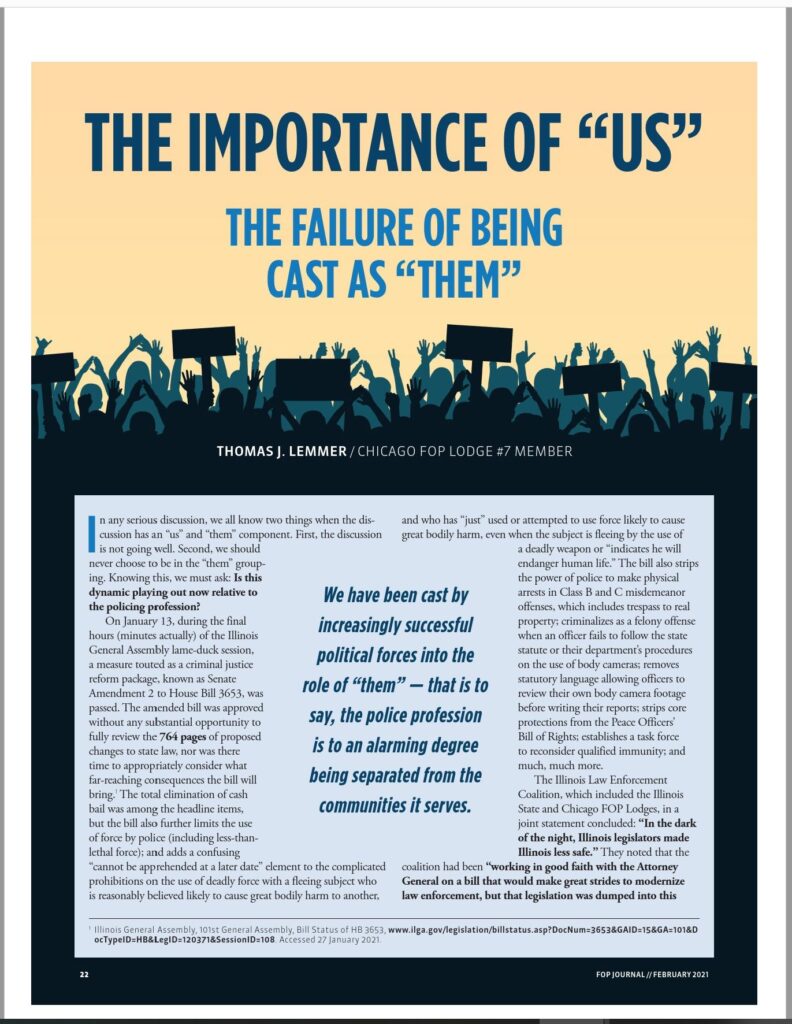
The Importance of “Us:” The Failure of Being Cast as Them
Abstract: The nation’s police officers have been cast by increasingly successful political forces into the role of “them”- that is to say, the police profession is to an alarming degree being separated from the communities it serves.
Whenever the police are viewed by the community – and worse by the police themselves – as separate and apart from the community, the police will fail in their public safety efforts. Disorder and violence will increase, and an increased frequency of incidents viewed as abuses of authority are inevitable. To regain the support necessary for our police officers to meet their mission, the voices of support for the police must be heard from across the community of us.
Published in the February 2021 issue of the FOP Journal by the National Fraternal Order of Police, pages 22-27.

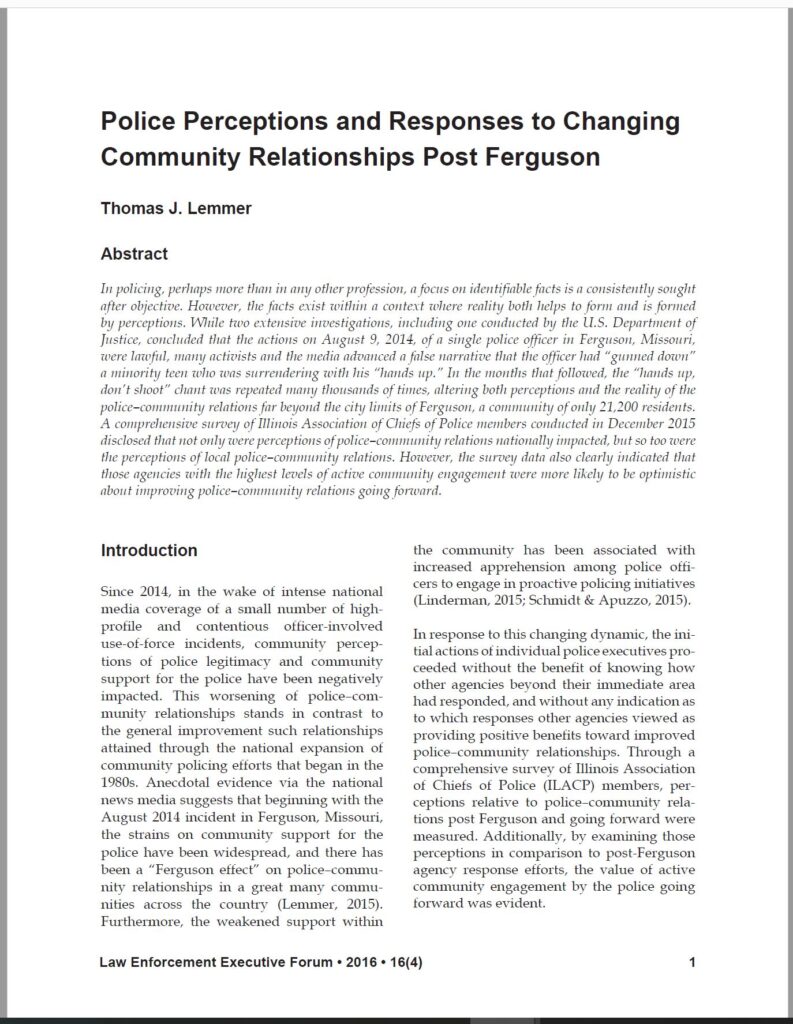
Police Perceptions and Responses to Changing Community Relationships Post Ferguson
Abstract: In policing, perhaps more than any other profession, a focus on identifiable facts is a consistently sought after objective. However, the facts exist within a context where reality both helps to form and is formed by perceptions.
While two extensive investigations, including one conducted by the United States Department of Justice, concluded that the actions on August 9, 2014 of a single police officer in Ferguson, Missouri were lawful, many activists and the media advanced a false narrative that the officer had “gunned down” a minority teen who was surrendering with his “hands up.” In the months that followed, the “hands up, don’t shoot” chant was repeated many thousands of times, altering both perceptions and the reality of police-community relations far beyond the city limits of Ferguson, a community of only 21,200 residents.
A comprehensive survey of Illinois Association of Chiefs of Police members conducted in December 2015 disclosed that not only were perceptions of police-community relations nationally impacted, but so too were the perceptions of local police-community relations. However, the survey data also clearly indicated that those agencies with the highest levels of active community engagement were more likely to be optimist about improving police-community relations going forward.
This article was published by in the journal Forum by the Executive Institute of the Illinois Law Enforcement Standards and Training Board in December 2016.


Changes in Police-Community Relations Post Ferguson
Abstract: The article provides a summary overview of the results from the author’s December 2015 survey of Illinois Association of Chiefs of Police members. The survey both gauged the extent of change in police-community relations post Ferguson and identified key strategies implemented by Illinois police agencies since August 2014 to strengthen police-community relations locally.
Among the key findings from the study, building safer and stronger communities is fundamentally an effort built upon trust and through active partnerships between individual local police departments and the communities they serve.
The survey data provides strong evidence that those respondents who reported higher levels of direct outreach efforts with the community were far more confident about the strength of their local police-community relationships going forward. As such, maintaining sustained community outreach is the core recommendation that can be drawn from the analysis of the survey data.
This article was published in Command Magazine by the Illinois Association of Chiefs of Police in September 2016.

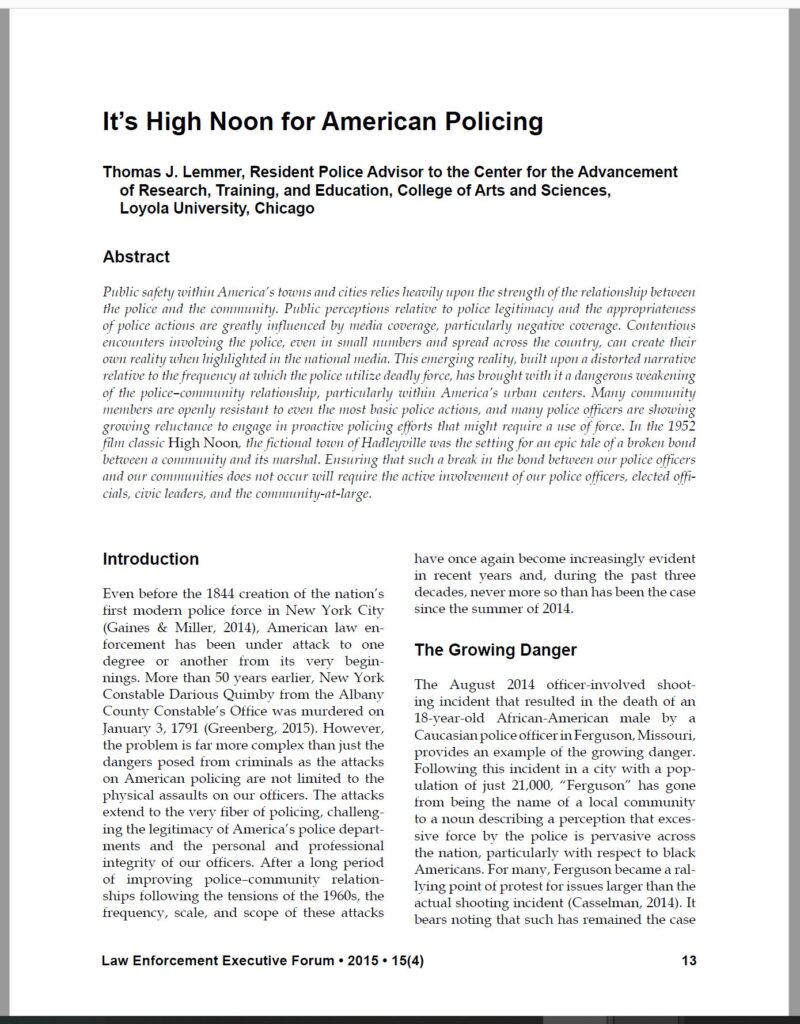
It’s High Noon for American Policing
Abstract: Public safety within America’s towns and cities relies heavily upon the strength of the relationship between the police and the community. Public perceptions relative to police legitimacy and the appropriateness of police actions are greatly influenced by media coverage, particularly negative coverage.
Contentious encounters involving the police, even in small numbers and spread across the country, can create their own reality when highlighted in the national media. This emerging reality, built upon a distorted narrative relative to the frequency at which the police utilize deadly force, has brought with it a dangerous weakening of the police–community relationship, particularly within America’s urban centers.
Many community members are openly resistant to even the most basic police actions, and many police officers are showing growing reluctance to engage in proactive policing efforts that might require a use of force. In the 1952 film classic High Noon, the fictional town of Hadleyville was the setting for an epic tale of a broken bond between a community and its marshal. Ensuring that such a break in the bond between our police officers and our communities does not occur will require the active involvement of our police officers, elected officials, civic leaders, and the community-at-large.
This article was published in the journal Forum by the Executive Institute of the Illinois Law Enforcement Standards and Training Board in December 2015.

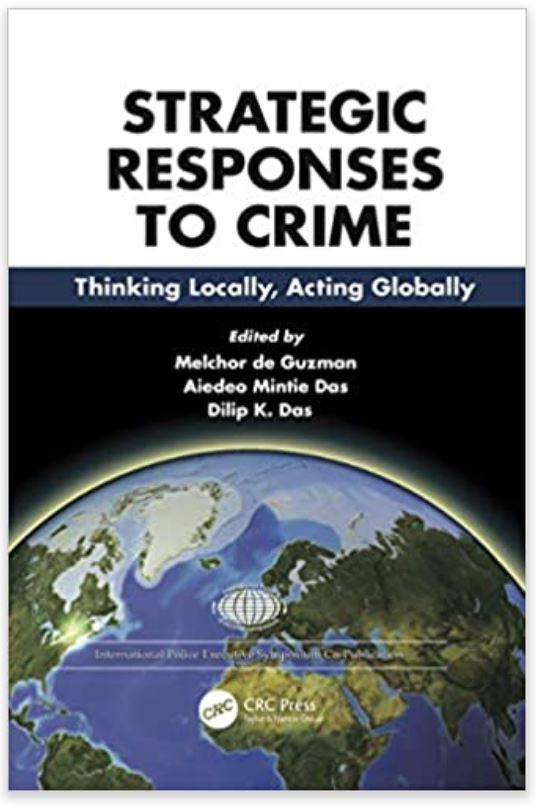
The War on Drugs in Chicago: Thinking Locally, Acting Globally
Abstract: With a population of 2.9 million people, Chicago is the third largest city in the Unites States. Located in America’s heartland, Chicago is one of the nation’s most important transportation centers and home to one of the world’s busiest airports: O’ Hare International.
A total of seven interstate highways run through the city; each day, thousands of trucks flow into Chicago’s 200 truck terminals. Chicago is also known for its ethnic diversity. Less than 50 percent of the city’s residents are Caucasians; the rest are African Americans, Hispanics (primarily of Mexican origin) and a growing South Asian population (the third largest in the United States after New York and San Francisco). Chicago’s greater metropolitan area, known as Chicagoland, boasts a population of between 8 and 10 million people.
The Complexity of the Chicago Experience
Chicago’s reputation for crime and corruption has been longstanding. Whether deserved or not, Al Capone’s legacy has been hard to shed. During the past 30 years, Chicago, like many other American cities, experienced a major rise in violent crime, which has gradually been declining since the mid-1990s. Last year (2005), Chicago recorded 448 homicides, the lowest total in 40 years. Still, the city’s location makes it a hub for the drug trade and an uninterrupted supply of opiates from four global sources: Mexico, South America, Southeast Asia and Southwest Asia. According to the Drug Enforcement Administration (DEA), drugs are trafficked into the city by commercial trucks, package delivery services, couriers, railways and cars (DEA, 2005).
This paper traces Chicago’s drug problem from the mid-1970s to the present, examines the scope and nature of the city’s current drug problem, and describes, in detail, the prevailing strategies and tactics deployed by law enforcement agencies to reduce the supply and demand for drugs. Because of the global nature of drug trafficking, attention is also paid to ongoing efforts to disrupt the production and trafficking of drugs destined for Chicago.
This conference paper was published as Chapter 4 in: “Strategic Responses to Crime: Thinking Locally, Acting Globally,” Dilip de Guzman , Melchor Das and Aiedeo Mintie Das (eds), CRC Press 2012, Boca Raton, Florida, p71–94.

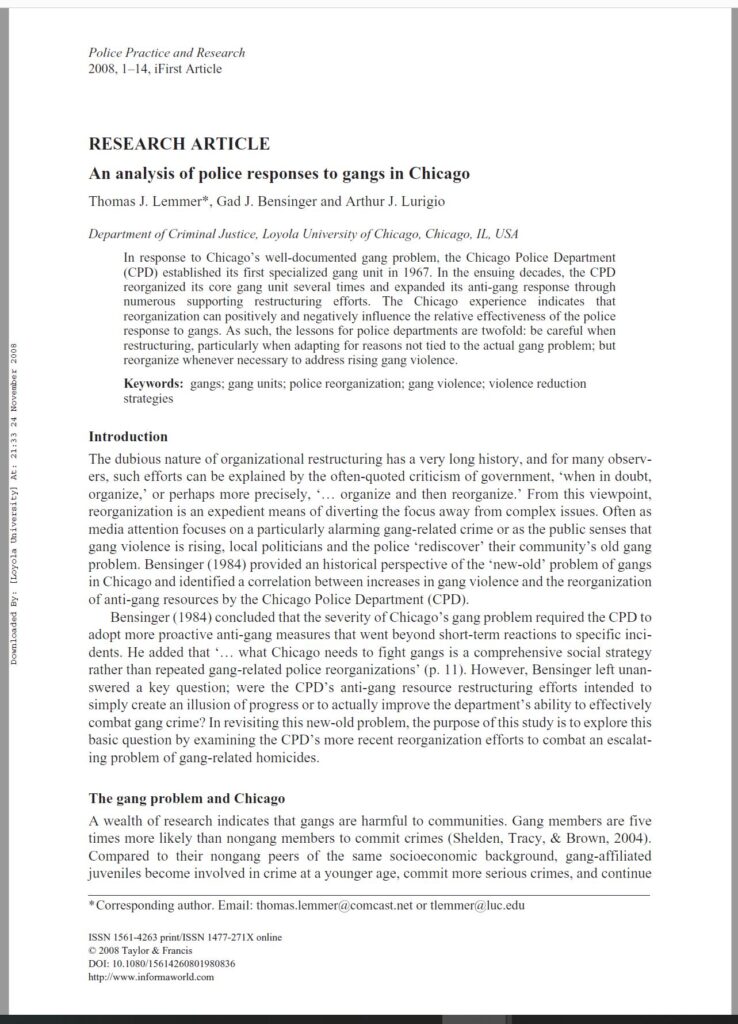
An analysis of police responses to gangs in Chicago
Abstract: In response to Chicago’s well‐documented gang problem, the Chicago Police Department (CPD) established its first specialized gang unit in 1967. In the ensuing decades, the CPD reorganized its core gang unit several times and expanded its anti‐gang response through numerous supporting restructuring efforts.
The Chicago experience indicates that reorganization can positively and negatively influence the relative effectiveness of the police response to gangs. As such, the lessons for police departments are twofold: be careful when restructuring, particularly when adapting for reasons not tied to the actual gang problem; but reorganize whenever necessary to address rising gang violence. This article December 2008 in the journal Police Practice and Research.

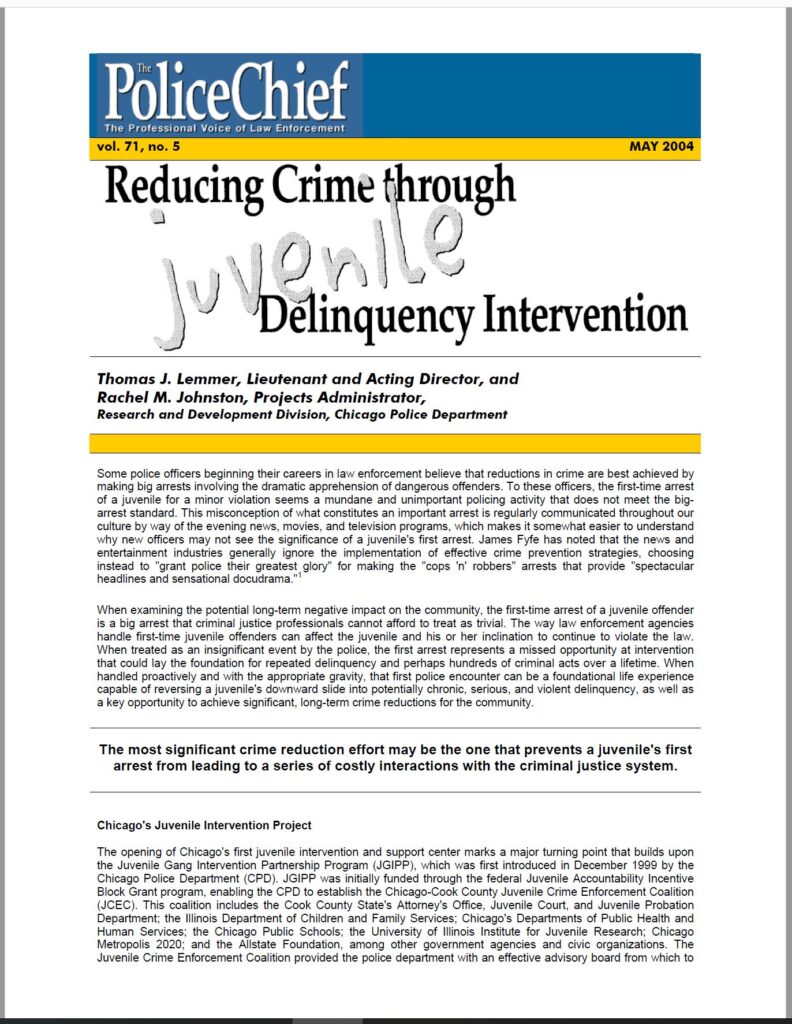
Reducing Crime Through Juvenile Delinquency Intervention
Abstract: Examination of the critical need for an effective intervention response from police at the time of a juvenile’s first few arrests and the potential for significant long-term crime reductions for the community when such a response to juvenile delinquency has been implemented. This article was published by the International Association of Chiefs of Police in the May 2004 issue of Police Chief magazine.

Additional Site Sections with More of Our Content
For more of our analysis and coverage of major public safety issues in the news and academic research, see our News & Research Analysis section. Join us there for insightful discussions and commentary. Selected postings from this section have been republished through our collaboration with LawOfficer.com. See our Working with Others section for more information.
Research and Topic Ideas?

Do you have an issue relating to the profession that you would like Secure 1776 to write about? Let us know.
To share your ideas, or to ask for additional information email us at admin@secure1776.us.

(c) 2022-2025 Secure1776.us – All rights reserved.

